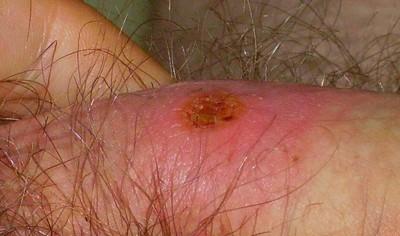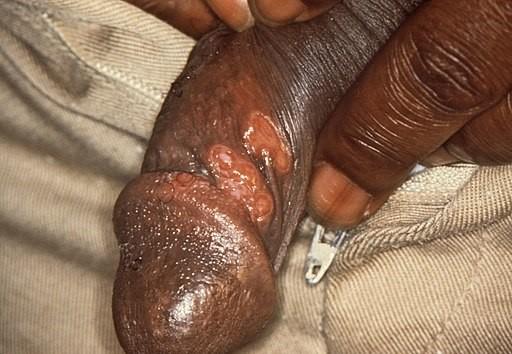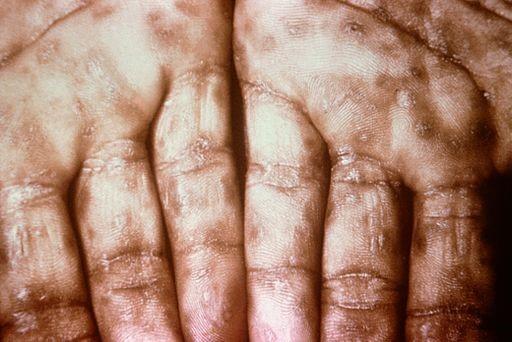Syphilis
Peer reviewed by Dr Krishna Vakharia, MRCGPLast updated by Dr Hayley Willacy, FRCGP Last updated 30 Jan 2023
Meets Patient’s editorial guidelines
- DownloadDownload
- Share
- Language
- Discussion
Syphilis is an infectious disease caused by a germ (bacterium) called Treponema pallidum. There are several stages of syphilis. The earliest stage usually causes an ulcer on your genital region. If the infection is not successfully treated, you can go on to develop symptoms in other parts of your body.
In this article:
What is syphilis?
Continue reading below
Syphilis symptoms
The symptoms of syphilis infection vary depending on how long ago you were infected. You can find out more about the symptoms of each stage in detail later in this leaflet, but in summary the symptoms include:
Primary syphilis (2-3 weeks to three months after contact with the germ)
One or more ulcers on your genital region or mouth, which are usually painless and go away on their own after about six weeks.
Secondary syphilis (if the infection wasn't treated, usually a month after first contact)
This is a non-painful rash, especially on hands and feet; feeling generally unwell and tired; swollen glands; joint pains and warty lumps on the genitals.
Tertiary syphilis (many years after first infection)
This is a serious complication affecting the nervous system, heart, blood vessels and skin.
What does syphilis look like?
The first two images below show what primary syphilis looks like.
The first image (below) shows white skin on the penis, with a single ulcer sitting in the middle of a reddened area.
Syphilis single chancre - primary infection

By Original uploader Pygmalion at German Wikipedia, CC BY-SA 3.0, via Wikimedia Commons
The next image also shows primary syphilis but there are two ulcers visible on the black skin of the penis.
Syphilis chancres - primary infection

By CDC/M. Rein, VD, Public domain, via Wikimedia Commons
The next image shows the rash on the palm of the hands and fingers in secondary syphilis.
Syphilis - secondary infection presentation

By CDC/Robert Sumpter, Public domain, via Wikimedia Commons
How do you get syphilis?
Sexual contact with an infected person
Syphilis is a sexually transmitted infection (STI). The infection is passed from person to person through contact with a syphilis sore (ulcer) - described below. So, depending where the ulcer is, the infection can be passed on during vaginal, anal, or oral sex without a condom.
Syphilis is one of the less common STIs in the UK. The number of cases are, however, rising. In the UK, the rates of infection are highest amongst men who have sex with men.
Syphilis is much more common in countries outside the UK, especially in developing parts of the world.
Note: syphilis is not spread by toilet seats, door knobs, bathtubs, shared clothing or eating utensils, etc. You need to have very intimate and direct contact with an infected person.
Syphilis infection in pregnancy
If you have syphilis and become pregnant, you can pass on syphilis to your unborn baby (fetus). It is passed on via the placenta. Infection in the fetus can lead to serious problems in pregnancy (see later) and/or congenital syphilis.
Blood transmission
Syphilis is also transmitted in the blood. Syphilis can be transmitted through receiving infected blood products (a blood transfusion). In the UK, all blood products are rigorously screened for infections, including syphilis and human immunodeficiency virus (HIV). However, syphilis can also be passed from person to person through sharing needles between injecting intravenous drug users (IVDUs).
Continue reading below
Classification of syphilis
Syphilis infection is divided up into:
Acquired syphilis
This is generally transmitted through sex with an infected partner. There are several stages:
Primary syphilis. This is the earliest stage and generally occurs from ten days to three months after infection. It typically causes a painless ulcer on your genitals.
Secondary syphilis. This is the second stage of syphilis. Many different symptoms can occur (see later) but usually last several weeks. They can, however, come and go for up to two years.
Latent syphilis. Latent means 'hidden'. This occurs after the symptoms of secondary syphilis have cleared. With latent stages of syphilis you have no symptoms. Latent syphilis can last for many many years. It is divided into two types:
Early latent syphilis. This lasts for a year or so and you are still infectious - that is, you can pass syphilis on to other people.
Late latent syphilis. About two years after secondary syphilis has cleared you can become non-infectious and are no longer able to pass syphilis on to others.
Tertiary syphilis. This is the final stage of syphilis. It can affect many organs of the body, including your brain and heart. It can result in death.
Congenital syphilis
This means syphilis infection that is passed from a pregnant mother to her unborn baby. It is divided into:
Early congenital syphilis. This is diagnosed in the first two years of life.
Late congenital syphilis. This is diagnosed after the age of 2 years.
Syphilis symptoms in detail
What are the stages of syphilis?
If left untreated, the infection typically follows the pattern of four stages as described above - primary, secondary, latent and final-stage (tertiary) syphilis. Neurosyphilis (syphilis affecting your brain) is considered separately, as it can occur at any stage of syphilis.
Primary syphilis
Typically, one small ulcer (sore) develops where syphilis germs (bacteria) enter your body. This ulcer is called a chancre. It is commonly on the penis in men, on the vulva or vagina in women, or on the back passage (anus) in either men or women. The ulcer usually appears about 2-3 weeks after having sex with an infected person but it may appear at any time up to three months later.
The ulcer is usually painless and about the size of a small coin. A clear fluid (serum) oozes from the ulcer. This fluid is highly infectious and teeming with germs. The ulcer lasts up to six weeks, then heals - but this does not mean the infection has gone.
When you have a syphilis ulcer, the nearby glands (lymph nodes) in your groin may swell. These feel like small lumps at the top of your legs in the groin crease.
Sometimes the primary stage is non-typical. For example:
You may have more than one ulcer.
The ulcer may be painful.
Pus may come from an ulcer.
The ulcer may be in your mouth (if you catch the infection during oral sex), or in the rectum (from anal sex).
The ulcer may be on the cervix in women and is not seen or felt.
You may have no symptoms, or very mild symptoms that you take little notice of.
People with HIV infection as well as syphilis tend to get multiple, deep, large chancres.
Secondary syphilis
If the primary ulcer is not treated, or not noticed, the germs may spread to many parts of your body. Symptoms of secondary syphilis may then develop. These tend to appear a few weeks after the ulcer has healed but may develop whilst the ulcer is healing. Symptoms of secondary syphilis are numerous and vary from person to person. Some symptoms are nonspecific and are similar to those that can occur with other medical problems.
Symptoms of secondary syphilis may include:
Rash. This is a common symptom of secondary syphilis. The rash consists of dark patches that appear on your skin, each about the size of a penny. The rash may occur in many areas of the body, or be only in a few areas. However, the palms of the hands and the soles of the feet are almost always involved. The rash is not usually itchy or painful.
Condylomata lata are wart-like growths that may develop around the penis in men, or vagina in women.
A feeling of 'unwellness' (general malaise) and tiredness (lethargy).
Mild high temperature (mild fever) and headaches are common.
Sore throat.
Joint pains.
Swollen lymph nodes may develop in various places in your body (such as your groin, armpits or neck).
Patchy hair loss (alopecia) can occur but is not that common.
Less commonly, inflammation may develop in other parts of your body such as the liver, eyes, brain, or kidneys.
Without treatment, the rash and other symptoms from secondary syphilis usually go after several weeks. However, they may come and go for up to two years.
Latent syphilis
After the symptoms of secondary syphilis have cleared, you may not have any symptoms for several years. In this 'hidden' (latent) period you may think that the disease has gone. In some cases, there is no further development. In the first year or so of latent syphilis you can still pass the infection on. After this time, you are no longer infectious to others but you still have syphilis infection. If left untreated, the germs can slowly damage various parts of your body and symptoms of the final (tertiary) stage may eventually appear.
Tertiary syphilis
Tertiary syphilis can develop many years after the initial syphilis infection. Some manifestations of the disease can occur up to 50 years later. Many of these complications are potentially very serious and can make you extremely unwell. Some problems are life-threatening and can lead to death if untreated.
Syphilis is not considered to be infectious in its tertiary stage. Tertiary complications are slowly progressive and can affect any organ of your body.
Tertiary syphilis may cause several types of complications:
Brain (neurological) complications. This is also called neurosyphilis (see next section).
Cardiovascular complications. These are problems affecting your heart and blood vessels (the cardiovascular system). Most commonly, syphilis affects the main blood vessel leading out of your heart (the aorta). Inflammation here can cause weakening of your aorta, which can stretch, forming an aneurysm. Aneurysms have thin weak walls and can burst (rupture), potentially leading to death. Even if an aneurysm does not rupture, it can seriously affect one of your heart valves (the aortic valve), leading to a heart murmur. In turn, the heart does not pump very well and becomes swollen (distended) with blood. This condition is known as heart failure. See the separate leaflets called Congestive Heart Failure and Anatomy of the heart for more details.
Gummatous disease. Gummas are soft growths (tumours) caused by inflammation. They are not cancerous (malignant) tumours but are long-term (chronic) and can affect any part of the body. They can grow on your skeleton and affect your joints; they can also cause large lumps in or under the skin. Gummas can grow on your internal organs (such as your liver) and affect organ function. Quite commonly they appear on your leg, below your knee. Gummas may be single or multiple and can vary in size between one and several centimetres. They can cause bone pain at night and the chronic inflammation can cause a high temperature and a low blood count (anaemia).
Neurosyphilis
This means that the syphilis infection is affecting your central nervous system (CNS). The CNS includes your brain, your spinal cord and their coverings (the meninges).
Neurosyphilis can occur at any stage of syphilis infection. However, commonly it is thought of as a tertiary complication, occurring late on in untreated disease. Neurosyphilis is generally a slow and gradual loss of mental and physical function, with alterations in mood and personality. It is possible to have a more acute illness which is quicker in onset and more severe. On average it occurs between one and ten years after the initial infection.
Neurosyphilis used to be a lot more common in the days before antibiotic treatment was widely available. Probably between 2 and 4 people in every 10 with syphilis infection, developed neurosyphilis. Neurosyphilis is now more common in people who also have HIV infection.
The four main types of neurosyphilis are:
Asymptomatic neurosyphilis (no symptoms). Before effective antibiotic treatment was available, 3-4 people in every 10 with secondary syphilis had neurosyphilis which did not cause any symptoms.
Meningovascular syphilis. This involves inflammation of the coverings and small blood vessels in your brain. On average, this complication occurs about seven years after initial syphilis infection. It can cause headaches and dizziness and can result in a stroke. Meningitis - inflammation of the coverings of the brain (the meninges) - can also occur as a more sudden-onset (acute) complication. Total loss of vision (severe sight impairment) and deafness can also occur.
General paresis. This is also known (historically) as 'general paresis of the insane'. It is a chronic dementia that represents a severe complication of neurosyphilis, usually in its late stages. On average, death follows within only 2-3 years. There is progressive personality change, memory loss and confusion. Sometimes depression or hallucinations occur.
Tabes dorsalis. This is another, late form of neurosyphilis, more common before antibiotic treatment. The nerves in the spinal cord are damaged, leading to poor balance and co-ordination and problems with walking. Additionally, there is loss of pain and temperature sensation in the feet. As a result, deep foot ulcers can occur.
Syphilis in pregnancy and congenital syphilis
Syphilis infection can be passed from a pregnant mother to her unborn baby (fetus), via the placenta. This can result in serious pregnancy complications such as:
Miscarriage. This means death of the fetus before 24 weeks of gestation.
Stillbirth. This means death of the fetus after 24 weeks of gestation.
Hydrops. This is a condition of severe swelling due to fluid (oedema) in the fetus. It is a serious condition that can result in death of the fetus.
Polyhydramnios. This is a condition of pregnancy where there is an abnormally large amount of amniotic fluid surrounding the fetus. This can cause serious pregnancy complications such as:
Placental abruption (where the placenta suddenly detaches from the uterus).
Postpartum haemorrhage (PPH) when there is excessive bleeding at delivery.
Preterm (premature) labour. This is labour and delivery of the baby before 37 weeks of gestation.
Congenital syphilis is syphilis infection in the baby or the child, transmitted from the mother. It is divided into early and late cases, dependent on when the child shows symptoms of syphilis infection. (See 'Classification of syphilis' section, above.)
Early symptoms and signs of untreated congenital syphilis occur before the age of 2 years. They include:
Rashes - typically a peeling rash of the palms, the soles and around the mouth and back passage (anus).
An enlarged liver and/or spleen.
Abnormal bone X-rays.
Enlarged glands (lymph nodes).
Yellowing of the skin or the whites of the eyes (jaundice).
Late congenital syphilis is rare. It can cause symptoms similar to neurosyphilis in an adult. Problems affecting the eyes and joints are seen, as well as deafness, gummas and dental abnormalities.
Continue reading below
How is syphilis diagnosed?
Syphilis can be difficult to diagnose just based on symptoms. This is because there are very many different symptoms and often these symptoms can occur with other conditions. This is why syphilis used to be called 'the Great Imitator' because it mimics many other illnesses.
Now, however, there are specific tests for syphilis. So, as long as it is suspected as a possibility, it can be easily diagnosed with a syphilis test.
Genitourinary medicine (GUM) clinics often also perform STI screening in order to look for other sexually transmitted infections. Testing for syphilis is part of this. There are two main types of test:
A small sample (swab) from the sore can be looked at under the microscope. The typical germs (bacteria) can be seen.
If the sore (ulcer) has gone, a blood test can detect if you have syphilis. The blood test looks for proteins in your blood, called antibodies. These antibodies are made by your immune system in order to fight infection. The antibody test can be positive or negative. A negative result might mean the test has been carried out too early. It can take a while for the antibodies to be present in the blood. If this is the case, a repeat test will usually be advised after a period of about three months. A positive test will either mean that you have syphilis or have had syphilis in the past.
Additionally, all pregnant women are screened for syphilis. This is part of the routine antenatal blood tests that are usually done between 8 and 16 weeks of pregnancy.
Sponsored
Are any other tests needed?
In primary and secondary syphilis, generally no other tests are required. However, in the final stage (tertiary syphilis), where there are complications affecting other parts of the body, further tests may be required.
Other tests may include a chest X-ray or ultrasound of the heart (echocardiogram, or 'echo') in cardiovascular syphilitic disease. Brain scans (such as computerised tomography (CT) or magnetic resonance imaging (MRI) may be needed if there is suspected brain (neurological) involvement.
Syphilis treatment
Because syphilis is caused by bacteria (germs), it is treatable with antibiotics.
Antibiotic injections are the usual treatment. Benzathine or procaine penicillin are the antibiotics usually used. This kills the syphilis bacteria and prevents the disease from progressing any further. The injections are given intramuscularly (IM), usually into the buttock. A single dose can be given for primary and secondary syphilis. Later stages may need a course of three injections, at weekly intervals. Neurosyphilis usually requires more frequent, daily doses for a couple of weeks.
Other antibiotics are sometimes used if you are allergic to penicillin. Azithromycin may be used in this situation but there is an increasing problem of resistance to this type of antibiotic.
Note: it is important to avoid any type of sexual activity until the syphilis sores are completely healed and until two weeks have passed after your treatment was completed.
Remember: it is not just penetration and ejaculation that lead to transmission of syphilis. It is caught by close skin-to-skin (sexual) contact with the oozing fluid (serum) from the ulcer (chancre).
Treatment during the primary or secondary stages of the disease will usually prevent any permanent long-term damage.
Some of the problems associated with the final stage (tertiary syphilis) cannot be completely cured with antibiotics. However, antibiotic treatment may prevent further worsening of your condition. Heart and blood vessel (cardiovascular) complications may still become worse, despite treatment.
If you have syphilis, you should usually be investigated, treated and followed up by a GUM clinic. If you have caught syphilis, there is a good chance that you may also have another STI. A GUM clinic will take small samples (swabs) and blood tests to exclude other STIs such as chlamydia, gonorrhoea and HIV. Local and national information is also available on the internet - for example, from the Family Planning Association's 'Find a clinic' service.
The GUM clinic can organise contact tracing. This means informing your previous sexual partners (confidentially and anonymously) that they need testing for STIs, including syphilis. This is especially important if you are unable or unwilling to do this yourself.
It is important to tell your current sexual partner(s) so that they can also be tested and treated if necessary.
Can syphilis be prevented?
If you practise safe sex, and always use a condom, your risk of catching syphilis (and other STIs) is very much reduced. However, condoms do not provide complete protection, as syphilis ulcers can sometimes be on areas not covered by a condom.
If you have had syphilis and had it treated, you can still be re-infected if you have sex with an infected person. (The antibodies in your blood are not sufficient to protect you from another infection if you come into contact with syphilis again.)
What should I do if I think I have syphilis?
If you suspect that you have syphilis, or another STI, see your GP or contact your local GUM clinic.
In the UK you can go to the local GUM clinic without a referral from your GP and many clinics offer a 'walk-in' service. All treatment at a GUM clinic is completely confidential and your GP does not have to be informed, if you do not wish them to be. (However, sometimes this can be very helpful as part of your continuing 'whole body' (holistic) medical care.) You can find out where your nearest GUM clinic is by the following methods:
Asking your GP practice.
Contacting your local hospital.
Checking in the telephone directory.
Search the NHS 'Find a clinic' service.
Patient picks for Sexually transmitted infections

Sexual health
Sexually transmitted infections
A sexually transmitted infection (STI) is an infection that can be passed from person to person when having sex. You can get an STI by having vaginal, oral, or anal sex. There are several different types of STI.
by Dr Hayley Willacy, FRCGP

Sexual health
HIV and AIDs
HIV and AIDS are not the same thing and people who get HIV infection do not automatically develop AIDS. In fact, due to advances in treatment, very few people in the UK with HIV go on to develop AIDS. Preventing HIV by having safer sex and avoiding the sharing of needles is key, but if you develop HIV infection, early diagnosis and treatment are life-saving.
by Dr Rachel Hudson, MRCGP
Further reading and references
- UK national guidelines on the management of syphilis 2015; British Association for Sexual Health and HIV (2015, updated 2019)
- WHO Guideline on Syphilis Screening and Treatment for Pregnant Women; Recommendations on syphilis screening and treatment for pregnant women, World Health Organization, 2017
- Satyaputra F, Hendry S, Braddick M, et al; The Laboratory Diagnosis of Syphilis. J Clin Microbiol. 2021 Sep 20;59(10):e0010021. doi: 10.1128/JCM.00100-21. Epub 2021 May 12.
- Tracking the syphilis epidemic in England: 2010 to 2019; An update on progress towards the Syphilis Action Plan prevention priorities, Public Health England, January 2021
- Hussain SA, Vaidya R; Congenital Syphilis
- O'Byrne P, MacPherson P; Syphilis. BMJ. 2019 Jun 28;365:l4159. doi: 10.1136/bmj.l4159.
- Syphilis; NICE CKS (Clinical Knowledge Summaries) December 2019. UK access only.
Continue reading below
Article history
The information on this page is written and peer reviewed by qualified clinicians.
Next review due: 29 Jan 2028
30 Jan 2023 | Latest version

Ask, share, connect.
Browse discussions, ask questions, and share experiences across hundreds of health topics.

Feeling unwell?
Assess your symptoms online for free
Sign up to the Patient newsletter
Your weekly dose of clear, trustworthy health advice - written to help you feel informed, confident and in control.
By subscribing you accept our Privacy Policy. You can unsubscribe at any time. We never sell your data.
